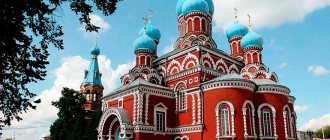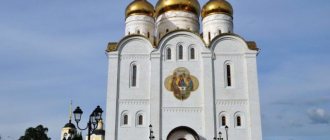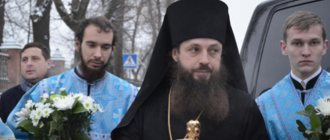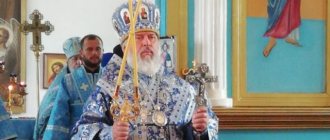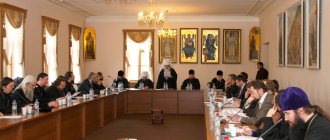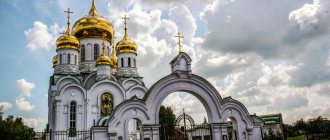| Ivanovo Metropolis on June 7, 2012. Photo from the website of the Ivanovo-Voznesensk diocese. |
Kineshma and Palekh diocese
of the Ivanovo Metropolis of the Russian Orthodox Church
- Diocesan administration: Russia, Ivanovo region, Kineshma, Volzhsky Boulevard, 4
- Tel/fax: +7 49331 55611
- Official site:
- Canonical territory: Verkhnelandekhovo, Zavolzhsky, Kineshma, Lukhsky, Palekhsky, Pestyakovsky, Puchezhsky, Rodnikovsky and Yuryevetsky districts of the Ivanovo region.
- Cathedral: Trinity-Uspensky in Kineshma, Holy Cross in Palekh
- On the map: Yandex.Map, Google map
Established on May 11, 1866 as a vicariate of the Kostroma diocese [1].
Named after the city of Kineshma. After 1936 it was not replaced. On June 7, 2012, the department was resumed as an independent diocese of the Ivanovo Metropolis. Separated from the Ivanovo-Voznesensk diocese as part of the Verkhnelandekhovo, Zavolzhsky, Kineshma, Lukhsky, Palekhsky, Pestyakovsky, Puchezhsky, Rodnikovsky and Yuryevets districts of the Ivanovo region.
Historical names
- Kineshemskaya (vicariate, May 11, 1866 - mentioned 1936)
- Kineshma and Palekh (since June 7, 2012)
Statistics
- December 2012 - no. population on the territory of the diocese - 228 thousand 200 people, area - 8935 sq. km. 2 monasteries (male and female), 61 parishes, 10 deaneries. The total number of churches is 86, chapels are 24, the number of prayer houses (with an altar) is 24. 94 full-time clergy (79 priests, 15 deacons), the number of clergy from the white clergy is 56 (46 priests, 10 deacons), the number of monastic parish clergy is 38 (33 priests, 5 deacons). Monastics staying in monasteries: monastic male monasticism without orders - 3 people. (robes), monastery male monasticism in ordination - 3 priests, monastery female monasticism - 6 people. (mantle 5, ryasophora 1). [2]
Bishops
Kineshma Vicariate of the Kostroma Diocese
- Jonathan (Rudnev) (September 4, 1866 - August 29, 1869)
- Palladium (Pyankov) (November 16, 1869 - June 24, 1872 [3])
- Gennady (Levitsky) (June 24, 1872 [4] - April 9, 1883)
- Veniamin (Platonov) (April 9, 1883 - June 13, 1905)
- Nikandr (Phenomenov) (July 10, 1905 - February 15, 1908)
- Innokenty (Kremensky) (February 24, 1908 - July 28, 1911)
- Arseny (Timofeev) (July 28, 1911 - July 30, 1914)
- Sebastian (Vesti) (September 8, 1914 - May 30, 1917)
- Sebastian (Vesti) (1919 - 1920)
- schisp. Vasily (Preobrazhensky) (September 19, 1921 - 1927)
- Nikolai (Golubev) (1929 - 1931)
- Alexander (Toropov) (September 21, 1932 - August 26, 1935)
- Sschmch. Boris (Voskoboynikov) (March 7, 1936 - July 1, 1936)
1927 - 1929 - not replaced
Kineshma diocese
- Hilarion (Kaigorodtsev) (since July 8, 2012)
Geography of deaneries
- Kineshemskoe (urban)
- Kineshemskoye (district):
- Kineshma
- village Upper Landeh
- Zavolzhsk
- village Luh
- village Palekh
- village Pestyaki
- Puchezh
- Rodniki
- Yuryevets
KINESHEMA AND PALEKH DIOCESE
Kineshma and Palekh diocese
The Kineshma and Palekh diocese of the Ivanovo Metropolis of the Russian Orthodox Church was formed by the decision of the Holy Father. Synod on June 7, 2012 within the boundaries of the Verkhnelandekhovo, Zavolzhsky, Kineshma, Lukhsky, Palekhsky, Pestyakovsky, Puchezhsky, Rodnikovsky and Yuryevets districts of the Ivanovo region. as part of the newly formed Ivanovo Metropolis (see Ivanovo-Voznesensk and Kineshma diocese). Ep. Kineshemsky and Palekhsky were appointed abbots on the same day. Hilarion (Kaigorodtsev), his episcopal consecration in the Moscow Cathedral of Christ the Savior on July 8, 2012 was led by Patriarch Kirill (Gundyaev) of Moscow and All Rus'. Cathedral churches - in honor of the Dormition of the Most Holy. Mother of God and in the name of the Holy Trinity in Kineshma, Holy Cross in the village. Palekh. The diocese is divided into 10 dean districts: Kineshma city, district, Verkhnelandekhovo, Zavolzhsky, Lukhsky, Palekhsky, Pestyakovsky, Puchezhsky, Rodnikovsky, Yuryevetsky. In Oct. In 2013, there were 62 parishes and 2 monasteries (male and female) in the diocese; the clergy of the diocese included 85 priests and 18 deacons. The EU has departments: missionary, for interaction with the Armed Forces, law enforcement agencies and Cossacks, and for religion. education and catechesis, work with youth, charity and social service, information.
Assumption Cathedral in Kineshma. 1745 Photograph. 2012
Assumption Cathedral in Kineshma. 1745 Photograph. 2012
In the XV-XVII centuries. a significant part of the territory of the diocese was part of the Suzdal district, in the 2nd half. XVI - beginning XVII century Kineshma, Lukhsky and Yuryevets (Yuryevets-Povolsky) districts appeared. In 1708 Kineshma district. was assigned to the Arkhangelsk province, Lukhsky district - to the Moscow province, Yuryevetsky district. was abolished, Yuryevets was assigned to the Kazan province, and in 1713 annexed to the Nizhny Novgorod province. In 1719 Kineshma district. transferred to the St. Petersburg province, Lukh remained in the Moscow province. In 1727 Yuryevetsky district. was restored as part of the Nizhny Novgorod province of the Nizhny Novgorod province. In 1778, Kineshma, Lukhsky and Yuryevets districts were included in the Kostroma province of the Kostroma governorship. In 1796, all these districts became part of the Kostroma province.
In the XV-XVII centuries. the main part of the territory of K. and P. e. was part of the Suzdal diocese, in the 18th century - in the Vladimir diocese (see Vladimir and Suzdal diocese), from 1796 - in the Kostroma diocese, from 1947 - in the Ivanovo diocese. On the territory of K. and P. e. there are a number of ancient cities: Kineshma (first mentioned in 1504), Lukh (mentioned in 1428/29), Yuryevets (first mentioned in the late 14th century). On the territory of K. and P. e. many unfolded. events of the Time of Troubles, in particular, the uprising in Yuryevets against False Dmitry II (1608) led by Fyodor the Red, suppressed in 1609 by the troops of A. Yu. Lisovsky, when Kineshma and Yuryevets were burned. May 26 (on this day in 1609 Lisovsky captured Kineshma) before the beginning. XX century was a day of remembrance for the fallen defenders of Kineshma; the custom of commemoration was revived in the 90s. XX century All R. In the 17th century, during the liturgical reform in the Russian Church (see Nikon, Patriarch of Moscow and All Rus'), the territory of K. and P. e. became one of the centers of the birth of the Old Believers. In 1652 approx. For 2 months, one of the main teachers of the Old Believers, Archpriest Avvakum Petrov, served as rector of the Cathedral of the Entry of Jerusalem in Yuryevets. Until the beginning XX century in Kineshma and Yuryevets districts, all the main rumors of the “old faith” existed. In the XVIII - beginning. XX century the main center of spiritual enlightenment in the southeast. counties of Kostroma province. was opened in 1791 within the walls of Tikhonov Lukhsky in honor of the Exaltation of the Cross of the Lord, the Lukhovsky monastery. In 1847, the school was transferred to Kineshma and it became known as Kineshma. A graduate of the Kineshma Duma was the Soviet military leader Marshal A. M. Vasilevsky (1895-1977). The school was closed in 1918.
Council in honor of the Entry of the Lord into Jerusalem (between 1733 and 1806) and c. in the name of the Great Martyr. St. George the Victorious and Blgv. book Georgy Vsevolodovich in the bell tower (1840). Photo. 2011
Council in honor of the Entry of the Lord into Jerusalem (between 1733 and 1806) and c. in the name of the Great Martyr. St. George the Victorious and Blgv. book Georgy Vsevolodovich in the bell tower (1840). Photo. 2011
Among the most significant temples of the region in the beginning. XX century included the cathedrals in Kineshma and Yuryevets. The Assumption Cathedral in Kineshma consists of the summer Assumption Church (1745), the winter Trinity Church (1838) and a 4-tier bell tower (1798). The Cathedral of the Entrance to Jerusalem in Yuryevets consists of the summer Church of the Entrance to Jerusalem (1733), the winter Assumption Church (1833) and a 5-tier bell tower (1840), in the 1st tier of which there was a church. in the name of the Great Martyr. George the Victorious and St. book Georgy (Yuri) Vsevolodovich (the alleged founder of Yuryevets).
In 1918, there was a change in the administrative-territorial division of the region. In 1918, Kineshma and Yuryevets districts from Kostroma province. were transferred to the newly formed Ivanovo-Voznesensk province. (since 1929 Ivanovo industrial region, since 1936 Ivanovo region). In church terms, both districts (from the late 20s of the 20th century districts) until 1936 remained part of the Kostroma diocese and were governed by the bishops of Kineshma, vicars of the Kostroma diocese (see Kineshma vicariate).
Church in honor of the Exaltation of the Holy Cross in Palekh. 1774 Photograph. 2012
Church in honor of the Exaltation of the Holy Cross in Palekh. 1774 Photograph. 2012
In the 20s XX century on the territory of modern K. and P. e. all mon-ri were abolished. At the turn of the 20s and 30s. there was a massive closure of churches in Kineshma: in 1927 the Resurrection and Exaltation of the Cross churches were closed, in 1929 - the Annunciation Church, in 1930 - the Ascension Church, in 1940 services in the Assumption Cathedral ceased. By 1941, none of the 12 temples in Kineshma were operational. In 1929 the Assumption Cathedral in Yuryevets was closed, and in 1931 the Cathedral of the Entrance to Jerusalem was closed. In 1931, the Assumption Cathedral in Lukha and the Transfiguration Cathedral in Puchezh were closed, and in 1933 the Holy Cross Church in Palekh was closed. In con. 30s mass abolition of rural churches in the region began. By 1941, of the 13 churches in Yuryevets, only the cemetery Church of the Holy Spirit was functioning; not a single functioning church remained in Lukha, Rodniki, Puchezh, or Palekh.
In the 20-30s. XX century victims of terror on modern territory. Dozens of clergy became K. and P. e., including the Hieromartyrs of Kineshma: Bishops Vasily (Preobrazhensky) and Boris (Voskoboinikov), Archpriests Konstantin Razumov, Pyotr Lebedev, John Dobrokhotov and Nikolai Bukharin, priests John Rozhdestvensky, John Rumyantsev, John Uspensky, Leonid Vinogradov and others. In 1947-1950. rector of Trinity Church in the village Vorontsov (Puchezhsky district) served as archimandrite. Rev. Leonty (Stasevich), here on May 2, 1950 he was arrested.
Tikhonov Lukhsky Monastery. Photo. 2012
Tikhonov Lukhsky Monastery. Photo. 2012
In 1945, the Assumption and Trinity Cathedrals in Kineshma were returned to the believers; the Assumption Cathedral soon became the 2nd cathedral church of the Ivanovo and Kineshma diocese. In the 1st half. 50s in connection with the rise in the level of the Volga due to the construction of the Gorky hydroelectric station near the city of Gorodets, churches in Yuryevets (Blagoveshchenskaya (1700) and Kazanskaya (1754)) and Puchezh (5 of 6 churches abolished in the 30s of the twentieth century) were demolished. ). In 1961, the Bogoroditskaya Church was closed. in the Ananyin Konets churchyard (Zavolzhsky district), Uspenskaya church. in the village Bortnitsy (Rodnikovsky district), Trinity Church. in the village Spas-Shelutino (Palekh district), in 1962 services in the Assumption Church ceased. in the village Mezhi (Rodnikovsky district), in Kineshma the Assumption and Trinity Cathedrals were again closed (in 1965 the Ivanovo diocese achieved the return of the Assumption Cathedral).
At the turn of the 80s and 90s. XX century The transfer of churches to believers began in the region. In 1989, the Epiphany Church was transferred to the Church. in Yuryevets, in 1991 - Trinity Cathedral in Kineshma, in 1993 - Holy Cross Church in the village. Palekh, in 1996 - Assumption Cathedral in Lukha, in 2010 - Ascension Church. in Kineshma. Construction of new churches began. In 1993-1996 in Rodniki, where not a single church remained, a stone church was erected in the name of St. book Alexander Nevsky. In 1999 in Puchezh the former. The store building was rebuilt into a center. in the name of St. Seraphim of Sarov. In 2003, an Orthodox school in the name of St. began operating in Kineshma. book Alexander Nevsky.
Those who labored in the lands of modern times are especially revered in the diocese. K. and P. e. Reverends Macarius of Unzhensky and Tikhon of Lukh, Blessed. Simon Yurievetsky, Hieromartyrs Bishop. Vasily (Preobrazhensky) and prot. Pyotr Rodnikovsky, blessed Alexy Yolnatsky. In the Epiphany (Simonovskaya) Church. in Yuryevets the relics of the blessed one rest in secret. Simon Yurievetsky.
Bishop
Ep. Hilarion (Kaigorodtsev; since July 8, 2012).
Monasteries
Active: Tikhonov Lukhsky (male, in the village of Timiryazevo, Lukhsky district, founded in the late 15th century, closed in 1930, resumed in 1995), Makariev Reshemsky (in the village of Reshma, Kineshma district, founded in the beginning. XVII century as male, from 1901 female, closed in 1927, resumed in 1998 as male, from 2006 female).
Abolished:
Bogoyavlensky (male, in the village of Khudynsky (now Lukhsky district), founded at the turn of the 14th and 15th centuries, abolished in the 1st half of the 18th century), Preobrazhensky (male, in Kineshma, founded earlier 1452, abolished in 1764), Bogoyavlensky (male, in Yuryevets, mentioned in 1584, abolished in 1719), Voskresensky Pushavsky (male, in Puchezh, founded in the late 16th century, abolished in 1764), Voznesensky (female, in Kineshma, founded in 1609, abolished in 1764, from 1869 community, from 1896 monastery, closed in the 20s of the XX century), Preobrazhensky (female, in Yuryevets, mentioned in 1627, abolished in the beginning. XVIII century), Troitskaya Krivoezerskaya empty. (male, on the left bank of the Volga, opposite Yuryevets, founded in 1634-1641, closed in the 20s of the 20th century, in the mid-50s of the 20th century fell into the flood zone), Tikhvinskaya Myacheva is empty. (male, located in the village of Myachevo, Yuryevets district, founded in the 1st half of the 17th century, abolished in 1764), Solovetsky Voskresensky (Lomova empty) (male, in Yuryevets, founded in 1653, abolished in 1686 ), Rozhdestvenskaya is empty. (male, on the Nodoga River, in the village of Pustyn (now does not exist, on the territory of the modern Kineshma district), mentioned in 1682, abolished in 1764, in 1796 assigned to the Makariev-Reshemsky Monastery as a monastery , closed in the 20s of the XX century), in honor of the Nativity of Christ (female, in the village of Reshma (now Kineshma district), mentioned in 1741, abolished around the 50s of the 18th century) , Boldyreva is empty. (male, located near the village of Boldyreva Pustyn Yuryevetsky district, abolished in 1764), Uspensky (female, in Kineshma, founded as a community in 1868, transformed into a monastery in 1896, closed in 1924).
Arch.: GAIO. F. R-2953.
Source: Altovsky I.P., priest. Consecration of the right side chapel at the Kinesha Assumption (Summer) Cathedral // Kostroma EV. 1900. No. 19. Part unofficial. pp. 533-541; Monastery for a house of detention // Privolzhskaya Pravda. 1923. March 14; The village of Podmonastyrnoye no longer exists // Ibid. 1930. March 25; Chernetsov G. G., Chernetsov N. G. Travel along the Volga. M., 1970. S. 44-59; Russian Orthodox Church in the 20th century on Ivanovo land: Sat. documents and materials. Ivanovo, 2010. pp. 40-41, 44, 63, 64, 79-84, 101-102, 127-128, 141-144.
Lit.: Altovsky I.P., priest. Kineshma in the Time of Troubles and her heroic feat on May 26, 1609 Kineshma, 1909; Abolished monasteries of the Kostroma diocese. M., 1909. S. 1-2, 10-11, 30-37; Bazhenov I. Review of the abolished monasteries and deserts of the Kostroma diocese // Kostroma EV. 1917. No. 12. Part unofficial. pp. 199-202; Polyakova L. L., Shlychkov L. A. Yuryevets: Putev. Yaroslavl, 1975; Shlychkov L. A. Leafing through the pages of time: Architectural monuments of the Ivanovo region. Ivanovo, 1983. S. 55-78, 88-95, 136-145; Damascene (Orlovsky), Hierom. Life of St. blzh. Alexy Yolnatsky. M., 1994; The life and miracles of the elder Archimandrite. Leonty (Stasevich): Materials for glorification. Vladimir, 1997; Sofronov V.D. The path to the temple. Rodniki, 1998; Tikhonov is empty. and Lukhsky region. Ivanovo, 1998; SPAMIR: Ivanovo region. M., 2000. Part 2. P. 64-86, 232-249, 303-491, 602-742; Part 3. pp. 6-199, 703-763; Lukhsky region: Reserved land. Ivanovo, 2003; Russian monasteries: Volga region: Kostroma, Ivanovo, Nizhny Novgorod, Yoshkar-Olinsk, Cheboksary dioceses. Novomoskovsk; M., 2003. S. 244-251, 260-267; Fedotov A. A. Cathedral of Ivanovo Saints. Ivanovo, 2003. pp. 8-11, 14-21, 29-35, 38-39, 42, 44-50; Sokolova V.N. Kineshma pre-trial detention center within the walls of the Assumption Monastery // Historical, cultural and natural potential of the Kineshma region: Materials 2nd region. local historian Conf., March 24-25, 2004 Kineshma, 2004. pp. 61-64; Vorobyov N.V. Time is the connecting thread: History of Kineshma DU and pedagogical. college. Ivanovo, 2008; aka. On the way to ancestral and spiritual origins. Ivanovo, 2010.
N. A. Zontikov
Achilles
Views: 3,213
I’ll try to be an “expert” or a “forecaster” for a little while, which, in general, is the same thing. At least, in the case of the former schema-abbot Sergius (Romanov), I guessed almost completely - even when they began to forbid him to speak publicly, and he disobeyed for the first time, I immediately predicted the whole logic of the further development of events - Romanov would be admonished, then banned, then deprived ordination (even I didn’t think of excommunication from the Church), and Romanov himself will go wild and will only strengthen the position of his sect, gathering adherents around him, because he will have nothing to lose, and he has great support. Now, by the way, the question is: will Romanov decide to proclaim himself a bishop or even a patriarch (the name “Middle Ural Patriarchate” is already circulating online in all seriousness). Or the diocese will decide to take emergency measures, with the involvement of the security forces, and Romanov will be forcibly evicted from the monastery or even locked up in his usual environment - behind bars.
In the case of the Chikhachev guru Schema-Archimandrite Ioannikis (Efimenko), the logic is also visible, but somewhat different. Let us remember that the diocese (first Ivanovo, then Kineshma) did not touch the Chikhachev “elder” for thirty years, because everything was fine, and later they were simply afraid. The Bishop of Kineshma, we recall, received threats, including physical violence - it’s not for nothing that so many criminally marginal subjects graze around Ioannikios.
But now the diocese had to act - after the publications on Achilles, and after us - in the secular media, after a request from a deputy and the establishment of an investigation - there was nowhere to go, it is possible that the patriarchy also shouted and ordered to “sort it out.”
And the diocese “sorted it out” - the “elder,” who was no longer serving due to disability (he had no leg), was banned from serving and removed from his position as abbot. But since Efimenko is registered in Chikhachevo, he will most likely remain there. As Archpriest Andrei Efanov , who was involved in this matter, said: it is impossible, they say, to prohibit citizen Efimenko from receiving people who come to him. (It’s definitely not possible? But taking the monk Efimenko and exiling him to rest in a distant monastery under the supervision of a strict superior and forbidding visitors there is weak?)
Now the diocese is going to try the schema-archimandrite in a church court. There is a possibility that he will be defrocked, and then they will simply wash their hands, saying that now all the affairs of citizen Efimenko are not our problem.
But the problem remains. Firstly, Efimenko is not Romanov, he does not attack either the patriarch or the president, he does not scandal publicly, and many still do not understand what exactly his fault is (especially since such “elders” are a dime a dozen in monasteries , and in parishes). Secondly, Efimenko’s adherents, just like Romanov’s adherents, will only rally even more around their guru - now for them he is a “persecuted righteous man”, they will immediately remember and compare him with Christ, who was persecuted and betrayed by the bishops.
Adherents Romanov and Efimenko are also united by contempt for Patriarch Kirill - it is very easy for the current far-right “conservatives” to feed accusations against Gundyaev as an “ecumenist” and a “heretic” who embraces the Pope. (And then the bishop of the Russian Orthodox Church recently took part in a common action with Pope Francis and Patriarch Bartholomew, thereby adding more wood to the fire under the feet of Patriarch Kirill.) And Covid (closing churches, disinfecting spoons, etc.) played a role among the “special believers” negative role, undermining the authority of the “cowardly” patriarch.
Now, no matter what the patriarchal speakers say or diocesan officials do, nothing helps. First, the “elders” - “gurus” are nurtured for decades in the bowels of the Russian Orthodox Church, they are glorified, awarded, films are made about them, they serve together with them, they are allowed to pilgrimage to them, and then, when the “elders” begin to cause inconvenience - with their speeches or topics, that criminal cases are being opened against them - they are trying to urgently get rid of such “brothers” as ballast, but this does not help much; on the contrary, it only increases the popularity of the persecuted guru. Romanov captured the monastery, took many nuns and several priests with him, and retained and increased thousands of supporters. And the flow of adherents to Efimenko will increase even more, especially if he remains in Chikhachevo.
It seems that the fight against sects within the Russian Orthodox Church can only become effective when they begin to fight not the consequences, but the causes. And a lot is said about the reasons on our website, for example, in our book on monasticism “Victims of the Angelic Order” . In the Russian Orthodox Church for thirty years they nurtured and cherished the cults of the elders - miracle workers, prayer books, healers, besogons, engaged in readings, sending hundreds of people to monasteries, of their own free will and at the request of the diocesan bishops, who needed to fill these monasteries. They indulged the people in their Orthodox paganism, making banal swindlers or deluded narcissists who believe in their “grace” old men in black robes as shepherds, and now it’s too late to clean it up, because the authority of the leadership of the Russian Orthodox Church has been lost, at least with the current leadership for sure. Whether anything will change with the change of Patriarch Kirill - time will tell. In the meantime, the time of the guru continues, the sheep are waiting to be speared and sent to the pigsty for obedience. As long as you don't hug the Pope.
PS After the ban on the service of the Chikhachev guru, his adherents became even more active on our Yandex Zen and YouTube channels. Their comments are of the same type: “Lies! Slander! Order for the Holy Father!
One typical comment even came to us in the mail, we will publish it, and you can draw your own conclusions:
"Good afternoon!
My name is Angelina, my family is from the Moscow region, and we have been visiting the temple where Ioannikios serves for more than 7 years.
We arrive early for the service so that we can sleep in the old church; if there is no room, then we can go to the new church.
The service is long, but in such a holy place you don’t notice how time flies, yes, it’s not advisable to go out during the service, but this is everyone’s business, and they lie that they don’t let you in and force you to stand for the service, you can calmly go outside, things don’t smell afterwards, as they write in the news (which takes months to air).
After the service you can go out to eat, it’s all free, no one takes money, and no one is forced to go eat.
A visit to the priest is the most joyful thing that can be, the priest is very good, kind, and after the first room he becomes a dear, close person with whom you want to have a heart-to-heart talk!
No one takes away things at the entrance to the priest (as they write in the news), I personally visited the priest more than 15 times, and no one demands money there either.
Also, last year my husband and I got married there, the price was 3000 (someone wrote 9000 - that’s a lie!)
All donations are from yourself!!!
If the priest tells someone to stay, then he sees that it is this person who needs help; he tells few people to stay there. If he speaks, then this is also for the person’s consideration; no one will force him! When you want, then you can leave!
My parents travel several times a year and live for 2-3 weeks, work for the Glory of God, you need to realize this, the work they did was not difficult, chopping wood, cooking in the kitchen, working in the garden, just like our ancestors lived all their lives!!! !!
We wanted to leave, we went to the priest, he gives a Blessing for the journey!
This is the most sacred place on earth, where you want and want to come!!!
I believe that people who slander this temple and Ioannikis should be prosecuted!!! I cried all day yesterday when I heard this news! It’s a pity that the authorities fell for the provocation of one woman, whose mother allegedly left her, it’s even scary to imagine what kind of daughter there is, from whom her mother simply ran away!!!
I hope services will resume!!!!
I want to attach my Instagram: angelinochkash
I want to attach my Instagram so that local or Moscow authorities can get acquainted with my family and supposedly don’t think that “we are used to this smell, but they don’t demand money from us because we don’t have any.”
We are for the church in Chikhachevo to be opened and Ioannikiy to continue to serve God!!!”
If you like our work, support us:
Sberbank card : 4276 1600 2495 4340 (Pluzhnikov Alexey Yurievich)
Or using this form, entering any amount:
